Bulletin – June 2014 Australian Economy Why Has the Net Income Deficit Narrowed?
- Download the article 604KB
Abstract
Between late 2010 and early 2013, Australia's net income deficit narrowed to its lowest point since the early 1990s. This article examines the reasons for this narrowing and finds that it was mainly due to declines in the average yields paid by Australian entities on their foreign debt and equity liabilities. The lower average yield paid on foreign debt liabilities reflects a combination of declines in Australian interest rates and an increase in the share of Australia's foreign debt attributable to the Australian Government, which pays a lower rate of interest than private sector borrowers. The decline in the average yield paid on foreign equity liabilities was largely due to declining profits for Australian resource sector firms over the period in question, as these firms have a relatively high degree of foreign ownership.
Background
Australia's current account balance has historically been in deficit, as domestic investment has typically exceeded domestic saving. The current account deficit (CAD) has been mirrored by sustained net capital inflows from the rest of the world (a financial account surplus), which has led to a net foreign liability position for the Australian economy.
Although the current account balance has been in persistent deficit throughout most of Australia's history, it has fluctuated over time. For example, in the years leading up to the global financial crisis, Australia's CAD widened from around 2 per cent of GDP in 2001 to around 7 per cent of GDP in 2007, but it has since narrowed to less than 1½ per cent of GDP in early 2014 (Graph 1).
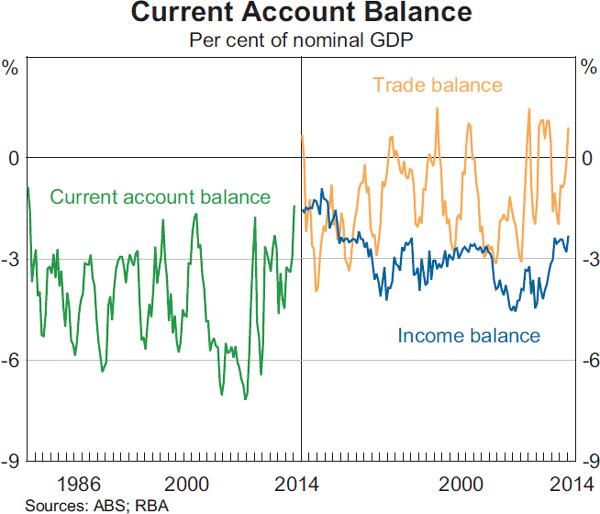
To understand the factors that influence the CAD, it is useful to decompose it into its two components: the trade balance and the income balance.
The trade balance is the difference between the revenue received by Australian entities for their exports of goods and services and the payments made by Australian entities for their imports of goods and services. This trade balance has fluctuated significantly between deficits and (small) surpluses over time, and has tended to drive most of the shorter-term fluctuations in the overall CAD. Since the peak in the CAD in 2007, the trade balance moved from a deficit of around 2½ per cent of GDP to a surplus of around 1 per cent of GDP in 2011. After moving back to a deficit of around 1½ per cent of GDP in 2012, the trade balance returned to a surplus by early 2014.
The income balance, on the other hand, has remained in persistent deficit. This net income deficit (NID) primarily reflects the fact that the income paid by Australian entities to non-resident investors (such as interest paid by Australian banks on their foreign borrowings) has consistently exceeded the income received by Australian entities on their overseas investments (such as dividend income earned by Australian superannuation funds on their holdings of foreign equities).[1] These ongoing net income outflows are the result of two main factors. First, the stock of Australia's foreign liabilities (on which a return is paid) has consistently exceeded the stock of foreign assets (which generates a return) (Graph 2, top panels). Second, the average yield paid on Australian entities' foreign liabilities has been consistently higher than the average yield received by Australian entities on their foreign assets (i.e. there has been a negative yield differential) (Graph 2, bottom panels).
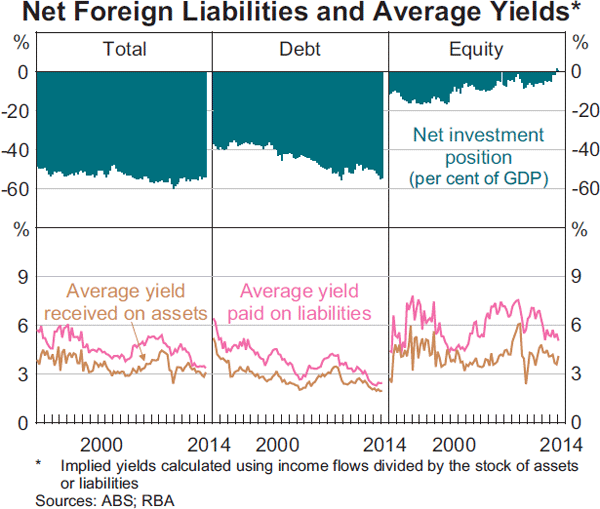
This combination of a net foreign liability position and a negative yield differential has been evident for both debt and equity investments, although the net equity liability position has declined over recent years.[2] While the negative yield differential on Australia's net foreign debt liability position has typically been narrower than that on Australia's net foreign equity liability position – and has narrowed further over recent years – net debt income outflows have historically accounted for an average of around two-thirds of the overall NID, reflecting the fact that Australia's stock of outstanding liabilities are primarily in the form of debt.
Historically, the NID has tended to make a larger contribution to the overall size of the current account deficit than the trade balance, but has had a smaller influence on the CAD's shorter-term fluctuations as the NID has typically been less volatile than the trade balance (Graph 1). The NID widened from around 2 per cent of GDP at the time of the float of the Australian dollar in 1983 to around 4 per cent of GDP in 1990, and has generally remained in a range of 2½ to 4½ per cent of GDP since then. However, since late 2010, the NID has narrowed significantly and has averaged around 2½ per cent of GDP since the first quarter of 2013 – around its lowest level since the early 1990s.
This article explores the factors that have underpinned the recent narrowing in the NID in further detail. It starts by decomposing changes in the NID into changes in gross income flows, and finds that the narrowing can be explained primarily by a decline in income payments on Australia's foreign liabilities. It then explores the drivers of this decline in income payments, including changes in the stock of Australia's gross foreign liabilities and declines in the average yield paid on these liabilities.
Gross Income Flows and the NID
A decomposition of Australia's gross income receipts and payments shows that the narrowing in the NID between late 2010 and early 2013 was driven primarily by a reduction in income payments on Australia's foreign liabilities (Graph 3). This reduction in income payments was evident for both debt and equity liabilities over this period, with the sizeable decline in equity income payments particularly notable given that equity liabilities account for only one-third of the stock of Australia's total foreign liabilities. Changes in income receipts on Australia's foreign assets had little effect on the NID between late 2010 and early 2013, with an increase in Australian entities' foreign equity income receipts roughly offset by a decline in debt and other income receipts.

Explaining the Decline in Income Payments on Australia's Foreign Liabilities
Income payments made by Australian entities to foreign investors depend on two key things: the stock of gross foreign liabilities and the average yield paid on these liabilities. Between late 2010 and early 2013, the decline in income payments was entirely due to declines in the average yields paid on foreign debt and equity liabilities, which more than offset modest increases in the stocks of gross debt and equity liabilities (Graph 4). These increases in the stocks of gross debt and equity liabilities primarily reflected continued inflows of debt and equity investment to Australia, although the stock of debt liabilities was also affected by valuation effects due to asset price changes between late 2010 and early 2013. By comparison, valuation effects associated with the appreciation of the Australian dollar over this period had a relatively small influence on the value of debt liabilities.[3]
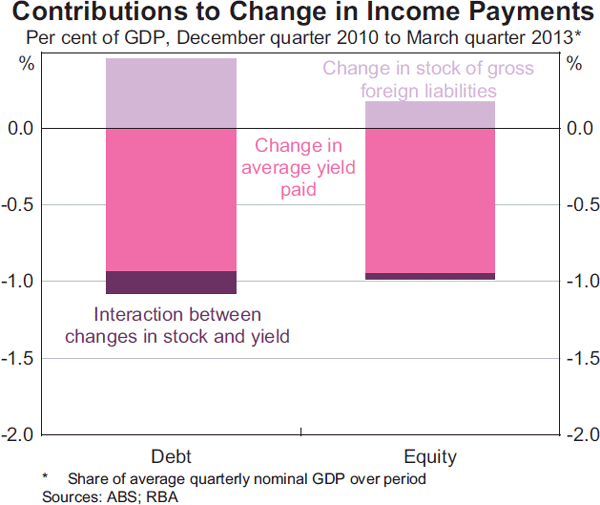
Given that changes in the average yield paid on Australia's foreign debt and equity liabilities have been the most significant driver of the narrowing in the NID, the remainder of this article examines the influences on these yields in more detail. It does so by considering the influences of two key factors: (i) changes in the yields paid on specific types of foreign debt and equity liabilities; and (ii) changes in the composition of foreign debt and equity liabilities.
Explaining the declining average yield on Australia's debt liabilities
The average yield paid by Australian entities on their foreign debt liabilities declined from around 3½ per cent in late 2010 to around 2½ per cent in early 2013, continuing a trend that had been evident since 2008 (Graph 5). It should be noted that this average yield – as implied from debt income flows in the balance of payments – does not necessarily represent the overall cost of Australian entities' borrowing from non-residents, as it only accounts for income paid directly on Australia's foreign debt liabilities, such as interest payments. In particular, the average yield does not include the cost of hedging the foreign exchange risk that would otherwise be associated with foreign currency borrowing: foreign currency borrowing accounts for around half of Australia's foreign debt liabilities and around 60 per cent of this is hedged back into Australian dollars (Rush et al 2013). Although hedging costs are accounted for elsewhere within the balance of payments (in the financial accounts), excluding them from the implied average yield means that this yield will understate the overall cost of servicing these liabilities.

A key factor contributing to the decline in the average yield paid on Australia's foreign debt liabilities over recent years has been a decrease in the marginal yields paid on specific types of debt liabilities; that is, declines in interest rates on debt issued by particular sectors and for particular maturities. While declines in marginal interest rates will immediately affect the average yields paid on new foreign debt issuance and on the stock of outstanding floating-rate foreign debt liabilities, in time it will also affect the average yield paid on outstanding fixed-rate foreign debt as this debt is rolled over when it matures. Marginal interest rates on a range of Australian debt instruments declined between late 2010 and early 2013; for example, interest rates on long-term Australian government debt, medium-term bank debt and short-term bank bill swap (BBSW) rates declined by 180 to 220 basis points over this period (Graph 6).[4]

The decline in Australian interest rates over the late 2010 to 2013 period coincided with a reduction in global interest rates, and was therefore also accompanied by a decline in the average yield received on Australia's foreign debt assets. However, the declines in Australian interest rates were more pronounced than the declines in global interest rates, with interest rate spreads on a range of Australian and overseas debt instruments narrowing over this period (Graph 7). This can be partly attributed to the reductions in the cash rate in Australia in 2011 and 2012, which totalled 175 basis points and occurred as policy rates in several large developed economies remained constrained by the zero lower bound.[5] The compression in interest rate spreads meant that the average yield paid on Australia's foreign debt liabilities fell by relatively more than the average yield received on foreign debt assets, thereby contributing to the narrowing of the NID.
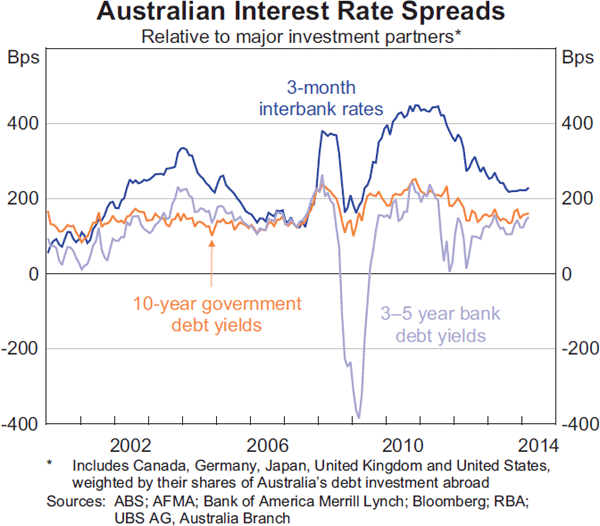
In addition to the decline in interest rates on specific types of debt liabilities, compositional changes in Australia's foreign liabilities have also affected the average yield paid, both through changes in the average maturity of debt and changes in the share of debt owed by different sectors of the economy.[6] These compositional changes appear to have worked in offsetting ways in terms of their influence on the average yield paid on Australia's foreign debt liabilities between 2010 and 2013.
Since the onset of the financial crisis, the share of longer-term debt liabilities has increased significantly. In particular, the share of Australia's debt liabilities with a residual maturity of more than five years increased from around 20 per cent in late 2010 to more than 30 per cent in 2013 (Graph 8).
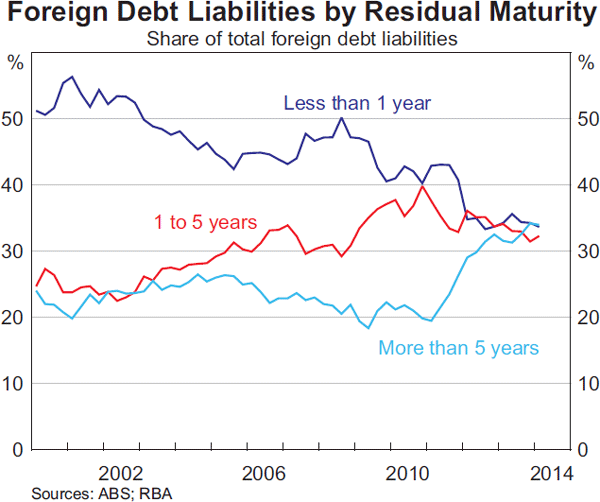
Ordinarily, longer-term debt attracts a higher interest rate than shorter-term debt obligations. Consistent with this, yield curves on both Australian government and bank debt have been upward sloping in recent years. Given this, the lengthening in the maturity of Australia's debt liabilities might, by itself, be expected to have increased – rather than decreased – the average yield paid on debt liabilities, resulting in a widening of the NID (all else equal).
However, the lengthening in the maturity of Australia's debt liabilities has been related to some notable changes in the sectoral composition of these liabilities. In particular, there has been an increase in the share of foreign liabilities owed by the government sector, which tends to issue debt with a longer average maturity than other sectors but also pays a lower rate of interest than the private sector on given maturities. Between 2009 and 2012, the Australian Government's share of long-term debt liabilities – that is, debt liabilities with a residual maturity of greater than one year – increased from less than 10 per cent to around 20 per cent, consistent with increased foreign demand for Australian government debt (Debelle 2014b) (Graph 9). Over the same period, the banking sector's share of long-term debt declined from around 55 per cent to around 45 per cent. This decline largely reflected a shift in Australian bank funding from foreign to domestic (i.e. deposit) sources in the post-crisis period, as the average maturity of bank debt liabilities increased over this period (Berkelmans and Duong 2014; RBA 2014). This compositional shift in Australia's long-term debt liabilities towards the government sector would, by itself, be expected to decrease the average yield paid on Australia's debt liabilities.
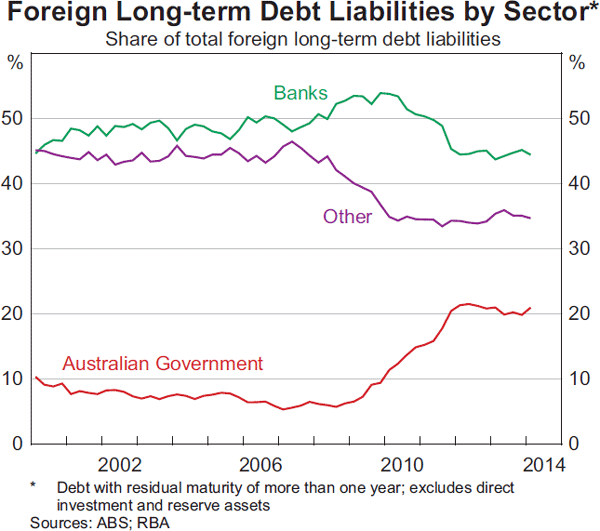
The net result of these changes was a compositional shift within Australia's foreign debt liabilities from shorter-term bank debt to longer-term government debt. While no breakdowns by sector or maturity are available for income payments on Australia's foreign debt liabilities, interest rates on longer-term Australian government debt have typically been lower than those on shorter-term Australian bank debt. As a result, it appears that the compositional shift towards longer-term government debt has contributed to the recent decline in the average yield paid on Australia's debt liabilities.
Explaining the declining average yield on Australia's equity liabilities
The average yield paid by Australian entities on their foreign equity liabilities decreased from around 7 per cent in late 2010 to around 5 per cent in early 2013 (Graph 10, left panel). This can be further decomposed into the yield paid on direct equity liabilities (i.e. foreign direct investment (FDI) in Australian equity, which includes reinvested earnings) and portfolio equity liabilities (e.g. shares in Australian companies owned by foreign residents).[7] This decomposition indicates that the decline in the average yield paid on Australia's equity liabilities between late 2010 and early 2013 primarily reflected a decline in the average yield paid on direct equity liabilities, with the average yield paid on portfolio equity liabilities little changed over the same period (Graph 10, right panel).
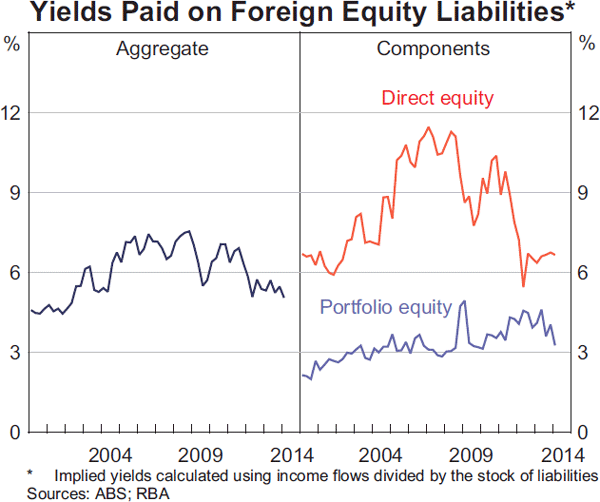
Income payments on Australia's direct equity liabilities include both retained earnings and dividend payments.[8] The average yield paid on these direct equity liabilities should therefore be closely aligned with the profits earned by firms in industries that attract sizeable direct equity investment from non-residents. As at the end of 2013, the top three destinations for FDI into Australia were the mining, manufacturing and finance industries (Table 1). In particular, more than one-quarter of foreign direct equity investment in Australia was in the mining sector, consistent with the relatively high share of foreign ownership in this sector.[9]
| Sector | Share |
|---|---|
| Mining | 26 |
| Manufacturing | 15 |
| Finance and insurance | 14 |
| Wholesale and retail trade | 10 |
| Property and business services | 7 |
| Transport and communication | 6 |
| Other | 22 |
|
Sources: ABS; RBA |
|
Consistent with this, the decline in the average yield paid on Australia's direct equity liabilities between 2010 and 2012 primarily reflected a fall in the yield paid on direct equity liabilities by the Australian mining sector (and, to a lesser extent, the manufacturing sector) (Graph 11). This is consistent with the decline in the return on equity of ASX 200 resource sector companies between 2010 and 2012 (though returns remained relatively high throughout this period compared with historical returns observed before the mining boom) (Graph 12). This in turn reflects sizeable capital expenditures in the resources sector over this period, as well as lower underlying profits due to declining commodity prices. More recently, as a number of mining companies have scaled back their capital expenditure in 2013, both the return on equity in the resources sector and the yield paid on direct equity liabilities by the mining sector have stabilised. This appears to have contributed to the observed stabilisation in the average yield paid on Australia's direct equity liabilities over 2013.
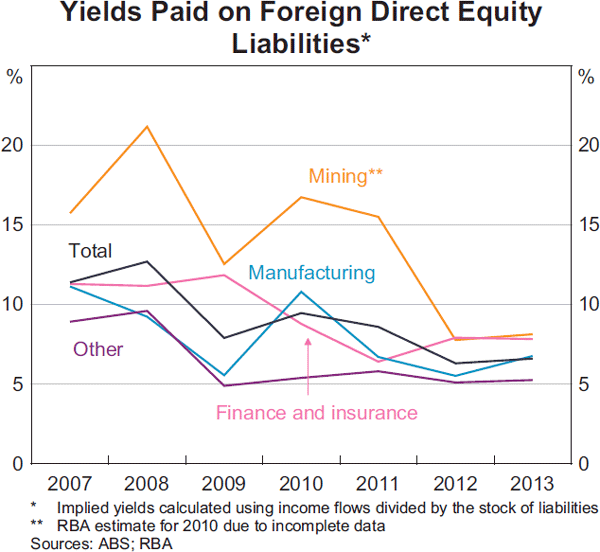
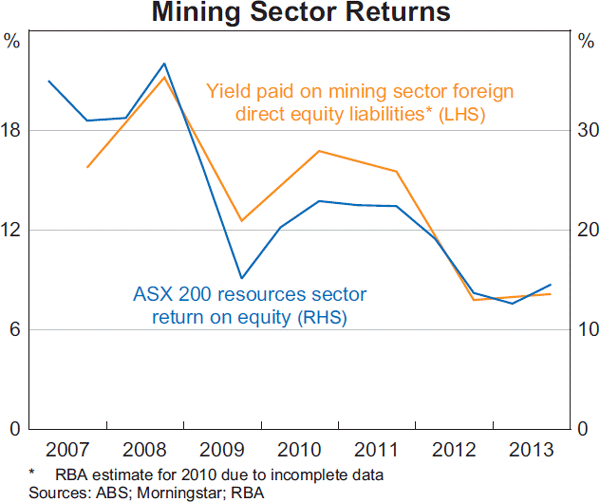
Theoretically, changes in the sectoral composition of Australia's foreign direct equity liabilities may also have affected the average yield paid on these liabilities in recent years. However, apart from a slight increase in the mining sector's share of total FDI liabilities, the sectoral composition of Australia's direct equity liabilities appears to have been little changed between late 2010 and early 2013. This suggests that changes in the composition of Australia's FDI liabilities are unlikely to have had a significant impact on the average yield paid on these liabilities over the 2010 to 2013 period.
Conclusion
Between late 2010 and early 2013, Australia's net income deficit declined to its lowest level since the early 1990s. This is due in large part to a reduction in the income paid on Australia's foreign liabilities, rather than an increase in the income received on Australia's foreign assets. The reduction in income payments on Australia's foreign liabilities has been evident for both debt and equity liabilities and, in both cases, these reductions reflect declines in the average yields paid on these liabilities, rather than declines in the stock of liabilities outstanding. The decrease in the average yield paid on Australia's debt liabilities reflects a combination of declines in Australian interest rates and a compositional shift towards lower-yielding government debt. The decline in the average yield paid on Australia's equity liabilities appears to be linked to the decline in the profitability of the Australian resources sector over this period.
Footnotes
The author is from International Department. [*]
Net income flows to and from Australia also include cross-border labour income receipts and payments and a secondary income component, which consists of other transfers such as foreign aid payments. These components are relatively small and are therefore excluded from this discussion. [1]
Australia recorded small net equity asset positions in the December quarter of 2013 and March quarter of 2014, partly reflecting positive valuation effects associated with the depreciation of the Australian dollar over the latter half of 2013. However, there were still net equity income outflows in both quarters, as the asset positions were not large enough to offset the ongoing negative yield differential. [2]
While Australia has an overall net foreign liability position, around two-thirds of Australian entities' foreign liabilities are denominated in Australian dollars, whereas most foreign assets are denominated in foreign currencies. As a result, Australia has consistently had a net foreign currency asset position. Hence, an appreciation of the Australian dollar increases the size of Australian entities' overall net foreign liability position by decreasing the Australian dollar value of foreign currency assets relative to foreign currency liabilities. See Rush, Sadeghian and Wright (2013) for more information. [3]
Marginal interest rates on Australia's foreign currency denominated debt liabilities also declined over this period. [4]
Reductions in the RBA's target cash rate typically result in declines in Australian interest rates for debt with longer maturities, albeit often to varying magnitudes. [5]
For a recent discussion of some of these compositional changes, see Debelle (2014a). [6]
More specifically, the ABS defines direct equity investment as investment where the investor has an equity interest of 10 per cent or more in an enterprise, while portfolio equity investment is defined as investment where the investor has an equity interest of less than 10 per cent. For more information, see ABS (1998). [7]
Retained earnings that are reinvested are recorded as a notional income outflow in the current account with an offsetting notional investment inflow in the financial account, although there is no actual flow of funds in these instances. [8]
Arsov, Shanahan and Williams (2013) estimate that around three-quarters of the Australian resources sector is foreign owned. [9]
References
ABS (Australian Bureau of Statistics) (1998), Balance of Payments and International Investment Position: Concepts, Sources and Methods, ABS Cat No 5331.0, ABS, Canberra, pp 131–144.
Arsov I, B Shanahan and T Williams (2013), ‘Funding the Australian Resources Investment Boom’, RBA Bulletin, March, pp 51–61.
Berkelmans L and A Duong (2014), ‘Developments in Banks' Funding Costs and Lending Rates’, RBA Bulletin, March, pp 69–75.
Debelle G (2014a), ‘Capital Flows and the Australian Dollar’, Speech to the Financial Services Institute of Australia, Adelaide, 20 May.
Debelle G (2014b), ‘The Australian Bond Market’, Speech to the Economic Society of Australia, Canberra, 15 April.
RBA (Reserve Bank of Australia) (2014), ‘Submission to the Financial System Inquiry’, March.
Rush A, D Sadeghian and M Wright (2013), ‘Foreign Currency Exposure and Hedging in Australia’, RBA Bulletin, December, pp 49–57.